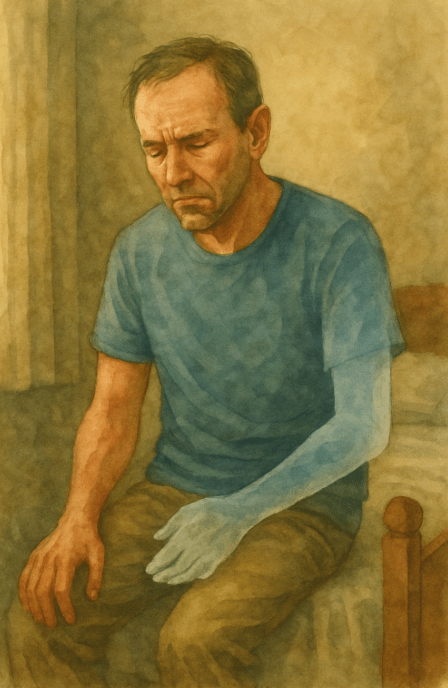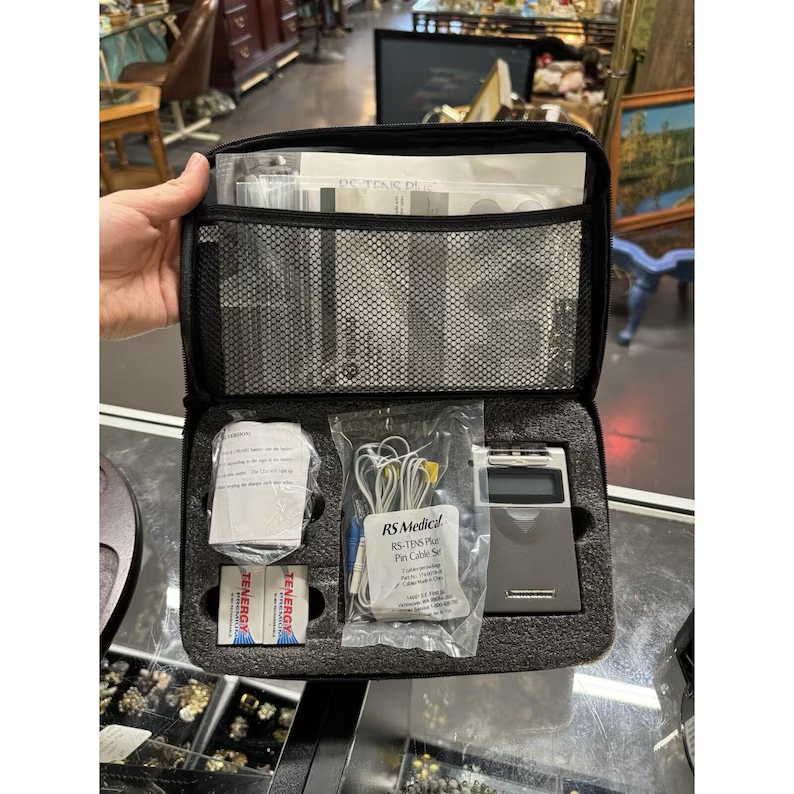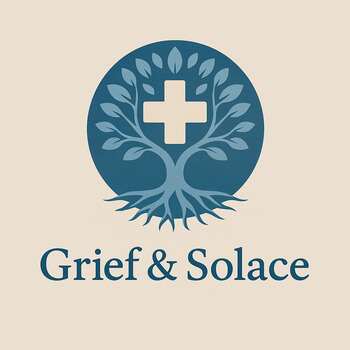Grieving Phantom Pain: When What’s Gone Still Hurts the Most
Grief with phantom pain is cruel and invisible, aching for limbs no longer there, mourning sensations that refuse to fade with time.

This post blends real grief with grounded knowledge. It isn’t clinical. It isn’t distant. It’s meant to sit beside you—not above you. The story you’ll read is meant to reflect what so many feel when living through or witnessing this condition: confusion, exhaustion, and quiet forms of courage.
If what you read feels familiar, please speak with your doctor. Your pain deserves more than silence.
He Lost His Arm, but the Pain Refused to Leave
They took his arm to save his life…
There wasn’t time to hesitate. Not after the infection. Not after his skin turned gray and his blood stopped responding. They said it had to go, elbow down, clean and fast.
And he didn’t resist. Didn’t cry. Didn’t scream. He just stared at the ceiling and nodded once, like a man who already understood loss, who had room for one more.
Afterward, he joked about it. Called it his “ghost limb.” He mused that maybe it was still wandering somewhere, flipping people off in traffic, trying to light cigarettes without him.
But then the pain began. And there was nothing funny about that.
He’d wake up sweating, clutching a hand that wasn’t there. Fingers he no longer possessed curled into a fist so tight it made his entire shoulder ache. He said it felt like his nerves were screaming in a language no one could understand.
They called it phantom pain…
🧠 Symptoms:
phantom pain:
– Pain that feels like it comes from the amputated limb
– Burning, throbbing, stabbing, cramping, or electric sensations
– May come and go, or persist continuously
– Can be triggered by emotional stress, weather changes, or physical touch
residual limb pain:
– Pain located in the remaining stump
– Prickling, throbbing, burning, stabbing, squeezing, or cramping
– May start soon after surgery or even years later
– Occasionally accompanied by involuntary movement of the stump
They said it was common, said it was complicated, said it might never go away.
He tried everything…mirror therapy, medications that dulled the edge but never took the blade, desensitization routines, nerve blocks, breathing exercises that only heightened his awareness of what was missing.
People asked if he missed using it. He said no. He missed not hurting.
The worst part wasn’t the absence; it was the presence of pain where absence should have been.
The part of him that was gone became the loudest part. He carried that noise into every room.
Some nights, I’d see him sitting in the dark, his good hand clenched, shoulders tight, trying to breathe through pain that had no wound to bandage, no place to press, no visible proof to explain why he was still breaking.
But he didn’t give in…
Complications:
– Difficulty using or adjusting to prosthetics
– Insomnia or sleep disturbances
– Emotional distress, anxiety, or depression
– Reduced mobility or independence
– Lower quality of life and increased isolation
Risk Factors:
– High level of pre-amputation pain
– Older age at time of amputation
– Height of the amputation on the limb
– Emotional stress, anxiety, or depression
– Poor prosthetic fit or usage issues
The arm was gone. But the pain stayed behind like a haunting…loud, invisible, and real as anything he’d ever held.
Causes:
phantom pain:
– Rewiring of the brain and spinal cord after limb loss
– Mixed signals from the nerves that once carried information from the missing limb
– Psychological and physical triggers may intensify pain
residual limb pain:
– Bone or soft tissue problems (sores, spurs)
– Neuromas (tangled nerve endings)
– Poor prosthetic fit
– Infection
– Nerve damage
– Poor blood flow to stump
– Tumors or scar tissue
He learned to walk through it, to talk about it, to say, “Yes, it hurts, even if you can’t see it.”
Slowly, he found new ways to live. New balance. New routines. He picked up tools again, one-handed, sure, but not lesser.
He taught his body to move differently, but he never let the ghost take more than it already had.
Prevention:
– Proper prosthetic fit and regular skin care
– Pre- and post-operative therapy
– Emotional support before and after surgery
– Routine stump inspections to prevent sores or infections
– Early treatment of nerve pain may prevent long-term phantom pain
📘 Diagnosis & Treatment
diagnosis:
– Physical examination of residual limb
– Imaging (X-ray, MRI, CT, ultrasound) to rule out bone injury, infection, or tumors
– Blood tests to rule out systemic infections or inflammation
– Pain localization to distinguish between phantom and residual limb pain
– Nerve block may be used diagnostically (especially for neuromas)
treatment:
medications:
– Over-the-counter pain relievers (ibuprofen, acetaminophen, naproxen)
– Opioids for severe cases (short-term use only)
– Tricyclic antidepressants or SNRIs for nerve-related pain
– Anticonvulsants (gabapentin, pregabalin) for nerve signaling interruption
– NMDA receptor antagonists (e.g., topical ketamine)
physical and occupational therapy:
– Mirror therapy (for phantom limb retraining)
– Compression garments to support nerve desensitization
– Muscle strengthening and coordination
– Prosthetic fitting and training
other therapies:
– Massage therapy
– Hypnosis (shown effective in small studies)
– Desensitization training (touch and vibration)
surgical and interventional:
– Nerve blocks to diagnose or temporarily relieve pain
– Neuromodulation:
– Spinal cord stimulation (SCS)
– Peripheral nerve stimulation (PNS)
– Transcutaneous electrical nerve stimulation (TENS)
– Osseointegration (direct prosthetic-bone attachment)
– Regenerative Peripheral Nerve Interface (RPNI): surgical graft to reduce neuroma formation
coping and support:
– Psychological counseling for trauma, grief, and body image changes
– Peer support from amputee communities
– Education for family and caregivers
– Pain tracking journals to identify triggers and treatment efficacy
– Spiritual or existential support for identity loss and adaptation
I know this is heavy, and I understand that the road ahead may feel like a tangle of loss and unanswered questions. But please hear this: you are not broken because you are hurting; you are not weak because you are afraid. You are living through something real, and survival itself is a kind of grace. You are allowed to struggle, you are allowed to hope, and you are allowed to not have all the answers today. Whatever comes next, you do not face it empty-handed; you carry every moment of love that shaped you, and that will always be enough to keep going.
🎀 Gifts to help With Phantom Pain
🏥 Everyday Comforts for Everyday Battles
Managing Phantom Pain often means needing a little extra help.
Sometimes it’s about restoring dignity, ease, or simply getting through the day with less pain.
These carefully chosen tools aren’t just items; they’re small bridges back to living.
This section is about finding practical support, never shame.
Transcutaneous Electrical Nerve Stimulation (TENS) Unit – Interruption for a Signal That Won’t Die
Phantom pain isn’t “in your head”—it’s misfired signals stuck in a loop. This portable TENS unit delivers controlled electrical pulses to nerve clusters around the residual limb, helping disrupt the brain’s pain messages. Compact, customizable, and noninvasive—it doesn’t erase the ghost, but it gives you a way to talk back.
🌿 Paths to Healing Beyond the Map
Sometimes traditional medicine isn’t enough.
If you’re exploring gentle, alternative options to help with Phantom Pain,
you might find comfort in plant-based compounds like **CBD or CBG**.
*This section is not medical advice, just a door left open.*
USA Medical Pain Relief Total Pack – Soothing the Body That Remembers What’s Missing
Phantom pain doesn’t respond to logic—it loops through the nervous system like grief. This Total Pack blends CBD, calming botanicals, and gentle inflammation support to ease the storm from within. It won’t convince your brain the limb is gone. But it may help reduce how loud the absence screams.
Need a Different Path Forward?
Every journey through grief looks different. Choose the next step that speaks to where you are now:
When You're Ready to Start Healing
Healing doesn’t mean forgetting.
It means finding small ways to carry your grief with strength and grace.
These are the stories, tools, and gentle steps to begin walking forward…at your own pace.
When You're Still in the Thick of It
Sometimes healing feels like a lie.
If you’re not ready to move on…if the pain still roars louder than the world wants to hear…this is the place where you’re allowed to feel it.
No sugarcoating. No pretending. Just truth.
When You're Holding on to Who’s Still Here
Grief reminds us to love louder.
If someone you love is still with you, this is your place to celebrate them, honor them, and create new memories while there’s still time.
Joy and sorrow can live side by side.






